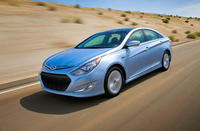2011 Hyundai Sonata Hybrid Review

2011 Hyundai Sonata Hybrid
|
SEE ALSO: Hyundai Buyers Guide
SEE ALSO: 2011 Hyundai Sonata Turbo Review
2011 Hyundai Sonata Hybrid
THE TRIPLE TREAT SEDAN
LINE-UP IS NOW COMPLETE
by Marty Bernstein
Senior Editor-at-Large
Detroit Bureau
That great looking, award winning, hot selling mid-size sedan you see
turning heads is one of two versions the 2011 Hyundai Sonata duo: the
2.4-liter gasoline direct injection model or the Sonata turbo for those who
like to add a little pepper in their driving. And now there’s a third
Sonata -- the new 2011 Hyundai Sonata Hybrid – which completes the
trio.
The Sonata Hybrid is the car for those who want to combine great
design, amazing mileage in a vehicle that is environmentally and
ecologically desirable. With an EPA rating of 35-mpg city, 40-mpg highway
the Sonata Hybrid achieves a new level of highway fuel economy for a
mid-size sedan. The company has said, “This is consistent with North
American driving habits which average more than 50% of their driving
mileage on highways.”
Sonata Hybrid’s fuel economy is powered by the
industry’s first application of third-generation lithium polymer
batteries which are more space efficient, lighter weight and offer higher
energy density than existing nickel-metal hydride and pending lithium-ion
applications. I’ve held the new battery which is about the size of a
#10 business envelope that’s filled with a few pages of junk mail and
was amazed by its small size and the fact that only 72 of these batteries
are used in the Sonata Hybrid.

|
Batteries are vital components in all hybrids since they power the
electric motor when the vehicle is in the electric mode, so I’m
devoting more space to tech-talk than usual. Rather than interpret others I
spoke with a Hyundai engineer during the preview of the Sonata Hybrid, who
when asked, explained the new battery’s benefits in non-tech-terms,
“These new batteries provide an excellent balance between power
delivery, energy density and thermal stability. Thermal stability is
critical to ensuring durability eliminating the need to replace the battery
pack during the normal lifespan of the vehicle. That’s because
electrodes in older lithium ion chemistries found in some hybrid vehicles
expand and contract with the heating and cooling that occurs during
charging and discharging. This thermal expansion causes cracks in the
electrodes which ultimately reduces the cell's ability to hold a
charge.”
Battery bottom line? Hyundai’s batteries have:
- Much lower expansion rates and are thus able to go through tens of
thousands of charge cycles even without having to use a heavier, liquid
cooling system.
- The Sonata's battery will hold its charge 25 percent longer than
hybrids with nickel metal hydride batteries. As a result the battery is
More likely to have usable energy in it when the car is started even if it
has been sitting for several days.
- This allows more electric starts and drive-aways, cutting both fuel
consumption and emissions and allows the Sonata to provide electric driving
boost more often and for longer periods of time.
- Lithium polymer also has less of the self-discharge characteristic
inherent in most rechargeable batteries.
Over the years I’ve driven so many hybrids I’ve lost
count, but it must be noted the first hybrid, the Toyota Prius now 12 years
old is still the market leader, but based on an extensive drive of the
Sonata is a serious challenger. Not only is the Sonata a true mid-size
sedan which means a lot more room, it looks like what it is – a
stylish, aerodynamic statement of automotive design and architecture
– not a bulbous shape small car and gets a better EPA efficiency and
mileage rating.
The Sonata hybrid shares the same "Fluidic Sculpture" design
language with all other 2011 Sonatas but features a unique exterior. The
combination of a re-shaped front and rear fascias with a deeper air dam,
extended rocker panels and lower drag wheels allow the air to flow around
the body with less resistance, but it retains the great Sonata design.
My recent test drive of the Sonata in California on two lane roads
in congested beach communities and on the states vaunted freeways was
impressive. Most hybrids have a perceptible, disconcerting lag as the
vehicle transitions from electric mode to gasoline powered engine, but the
Sonata Hybrid.
There was no lag, no audible sound either -- it was
undetectable. And it drove and handled like the other Sonata’s in the
Hyundai trio of midsize sedans with the cashmere soft six-speed automatic
transmission.. It can be driven in zero emissions, fully electric drive
mode at speeds up to 62 miles per hour (maybe a bit higher) or in blended
gas-electric mode at any speed. When the car comes to a stop and the
electrical load is low, the engine is shut down to completely eliminate
idle fuel consumption and emissions.
Keeping with Hyundai’s simplified approach to product
packaging, the Sonata Hybrid comes in just two models from the factory
– the very well-equipped Sonata Hybrid at $25,795, and the incredibly
well-equipped, tech-feature-packed Premium version at $30,795. Coming to
Hyundai dealers now to complete the triple treats of Sonata.








